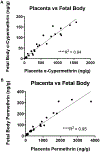Maternal and fetal tissue distribution of α-cypermethrin and permethrin in pregnant CD-1 mice
- PMID: 36059860
- PMCID: PMC9435064
- DOI: 10.1016/j.envadv.2022.100239
Maternal and fetal tissue distribution of α-cypermethrin and permethrin in pregnant CD-1 mice
Abstract
Pyrethroid insecticides are widely used throughout agriculture and household products. Recent studies suggest that prenatal exposure to these insecticides may adversely affect fetal development; however, little is known about the distribution of these chemicals in pregnant animals. The present study aimed to address this gap in knowledge by investigating the distribution of two commonly used pyrethroid insecticides, permethrin and α-cypermethrin, in maternal and fetal tissues of pregnant CD-1 mice. Dams were dosed from gestational days 6 to 16 via oral gavage with permethrin (1.5, 15, and 50 mg/kg), α-cypermethrin (0.3, 3, and 10 mg/kg), or corn oil vehicle. Pyrethroid levels were determined in gestational day 16 tissues collected 90 min after the final dose was administered. Across maternal tissues, levels of both pyrethroids were the highest in maternal ovaries, followed by liver and brain, respectively. In addition, levels of both pyrethroids in maternal tissues and placenta were significantly higher than those in the fetal body and amniotic fluid, suggesting that these compounds may exhibit low transfer across the mouse placenta. While additional toxicokinetic studies are needed to verify the time course of pyrethroids in the fetal compartment, these findings support investigation into indirect modes of action relevant to the effects of pyrethroids on mammalian fetal development.
Keywords: Fetal; Placenta; Pregnancy; Pyrethroid; Tissue distribution.
Figures






Similar articles
-
Maternal α-cypermethrin and permethrin exert differential effects on fetal growth, placental morphology, and fetal neurodevelopment in mice.bioRxiv [Preprint]. 2025 Mar 17:2025.03.16.643434. doi: 10.1101/2025.03.16.643434. bioRxiv. 2025. Update in: Toxicol Sci. 2025 May 30:kfaf079. doi: 10.1093/toxsci/kfaf079. PMID: 40166261 Free PMC article. Updated. Preprint.
-
Maternal α-cypermethrin and permethrin exert differential effects on fetal growth, placental morphology, and fetal neurodevelopment in mice.Toxicol Sci. 2025 May 30:kfaf079. doi: 10.1093/toxsci/kfaf079. Online ahead of print. Toxicol Sci. 2025. PMID: 40517329
-
Combined Maternal Exposure to Cypermethrin and Stress Affect Embryonic Brain and Placental Outcomes in Mice.Toxicol Sci. 2020 Jun 1;175(2):182-196. doi: 10.1093/toxsci/kfaa040. Toxicol Sci. 2020. PMID: 32191333 Free PMC article.
-
Parameters for pyrethroid insecticide QSAR and PBPK/PD models for human risk assessment.Rev Environ Contam Toxicol. 2012;219:1-114. doi: 10.1007/978-1-4614-3281-4_1. Rev Environ Contam Toxicol. 2012. PMID: 22610175 Review.
-
Neurobehavioral toxicology of pyrethroid insecticides in adult animals: a critical review.Neurotoxicol Teratol. 2008 Mar-Apr;30(2):55-78. doi: 10.1016/j.ntt.2007.10.005. Epub 2007 Nov 17. Neurotoxicol Teratol. 2008. PMID: 18206347 Review.
Cited by
-
Maternal α-cypermethrin and permethrin exert differential effects on fetal growth, placental morphology, and fetal neurodevelopment in mice.bioRxiv [Preprint]. 2025 Mar 17:2025.03.16.643434. doi: 10.1101/2025.03.16.643434. bioRxiv. 2025. Update in: Toxicol Sci. 2025 May 30:kfaf079. doi: 10.1093/toxsci/kfaf079. PMID: 40166261 Free PMC article. Updated. Preprint.
-
Pyrethroid pesticide exposure and placental effects.Mol Cell Endocrinol. 2023 Dec 1;578:112070. doi: 10.1016/j.mce.2023.112070. Epub 2023 Sep 16. Mol Cell Endocrinol. 2023. PMID: 37722502 Free PMC article. Review.
-
Developmental pyrethroid exposure in mouse leads to disrupted brain metabolism in adulthood.bioRxiv [Preprint]. 2024 May 28:2023.10.13.562226. doi: 10.1101/2023.10.13.562226. bioRxiv. 2024. Update in: Neurotoxicology. 2024 Jul;103:87-95. doi: 10.1016/j.neuro.2024.06.007. PMID: 37961675 Free PMC article. Updated. Preprint.
-
Developmental pyrethroid exposure causes a neurodevelopmental disorder phenotype in mice.PNAS Nexus. 2023 Apr 25;2(4):pgad085. doi: 10.1093/pnasnexus/pgad085. eCollection 2023 Apr. PNAS Nexus. 2023. PMID: 37113978 Free PMC article.
-
Developmental pyrethroid exposure in mouse leads to disrupted brain metabolism in adulthood.Neurotoxicology. 2024 Jul;103:87-95. doi: 10.1016/j.neuro.2024.06.007. Epub 2024 Jun 12. Neurotoxicology. 2024. PMID: 38876425 Free PMC article.
References
-
- Alonso MB, et al., 2015. Toxic heritage: maternal transfer of pyrethroid insecticides and sunscreen agents in dolphins from Brazil. Environ. Pollut 207, 391–402. - PubMed
-
- Amaraneni M, et al., 2016. Plasma protein binding limits the blood brain barrier permeation of the pyrethroid insecticide, deltamethrin. Toxicol. Lett 250-251, 21–28. - PubMed
-
- Bernucci L, et al., 2006. Diverse calcium channel types are present in the human placental syncytiotrophoblast basal membrane. Placenta 27 (11-12), 1082–1095. - PubMed
Grants and funding
LinkOut - more resources
Full Text Sources
Miscellaneous
